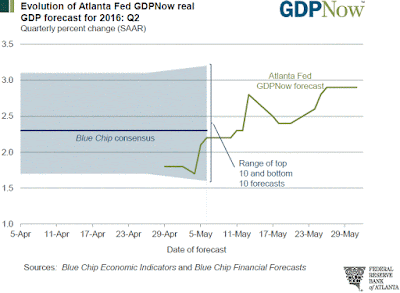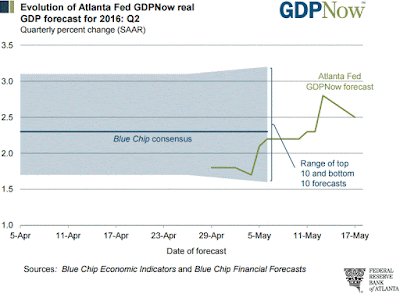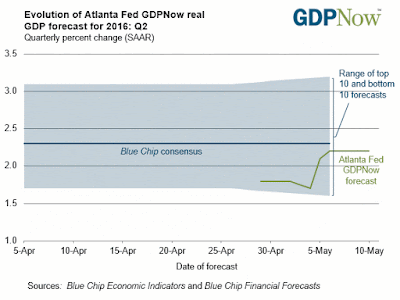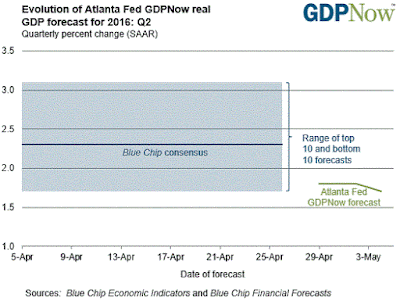Latest GDPNow Real Gross Domestic Product Forecast for Q2:2016
==============
Latest Forecast for Q2, 2016: +2.9%
Previous Reading: +2.9%
 |
| GDPNow Forecast |
From Today's Report:
"...The GDPNow model forecast for real GDP growth (seasonally adjusted annual rate) in the second quarter of 2016 is 2.9 percent on May 31, unchanged from May 26. The second-quarter forecast for real consumer spending growth remained at 3.6 percent after this morning's personal income and outlays release from the U.S. Bureau of Economic Analysis..."
About The GDPNow Forecast Model:
"...The growth rate of real gross domestic product (GDP) measured by the U.S. Bureau of Economic Analysis (BEA) is a key metric of the pace of economic activity. It is one of the four variables included in the economic projections of Federal Reserve Board members and Bank presidents for every other Federal Open Market Committee (FOMC) meeting. As with many economic statistics, GDP estimates are released with a lag whose timing can be important for policymakers. For example, of the four scheduled 2014 release dates of an 'advance' (or first) estimate of GDP growth, two are on the second day of a scheduled FOMC meeting with the other two on the day after the meeting. In preparation for FOMC meetings, policymakers have the Fed Board staff projection of this 'advance' estimate at their disposal...
...The Atlanta Fed GDPNow model also mimics the methods used by the BEA to estimate real GDP growth. The GDPNow forecast is constructed by aggregating statistical model forecasts of 13 subcomponents that comprise GDP. Other private forecasters use similar approaches to 'nowcast' GDP growth. However, these forecasts are not updated more than once a month or quarter, are not publicly available, or do not have forecasts of the subcomponents of GDP that add 'color' to the top-line number. The Atlanta Fed GDPNow model fills these three voids..."
Labels: Atlanta_Fed, Federal_Reserve, GDP, GDPNow
|
--> www.FedPrimeRate.com Privacy Policy <--
CLICK HERE to JUMP to the TOP of THIS PAGE > SITEMAP < |







